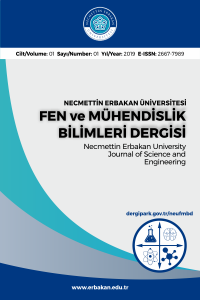3D Beden Ölçülerinin 2D Görüntülerden Elde Edilmesi için Net Silüetler
3D beden ölçülerinin 2D görüntülerden elde etmek için net silüetler gerekmektedir. Yazarların 3D beden ölçülerini elde etmek için 2D görüntülerden piksel koordinatları ile yeni bir yöntem geliştirdikleri devam eden araştırmalarında el ile ve beden tarayıcıları ile yaygın olan beden ölçüsü almak için bedene ihtiyaç duyulmayacağı için ve giysilerin e-alışverişler ile artması ile ortaya çıkan bedene oturmama probleminin çözülmesi amaçlandığı için, ilk adım, önden ve yandan çekilmiş fotoğraflardan net beden silüetlerinin elde edilmesidir. Bu makalenin amacı, net beden silüetlerinin elde edilmesi için, yeni geliştirilen ve Image Processing 1.0 ve Image Processing 2.0 adları verilen görüntü işleme programları ve yine yeni geliştirilen ve Python 1.0 adı verilen programın geliştirilmesinde yapılan araştırmaların sunulmasıdır. Geliştirilen bu yeni programlarda izlenen işlem basamakları, önden ve yandan görüntülerde renkli görüntüyü gri tona dönüştürerek bir beden silüeti elde etmek, eşik değerleri ve ikili dönüşüm, farklı eşik değeri algoritmalarının uygulanması ile karşılaşılan problemlerin tanımlanması, Paint 3D programı ile arka planın kaldırması (arka planın temizlenmesi) (gürültünün azaltılması), kenar algılama algoritmasını çalıştırılması (Sobel filtresi) ve elde edilen görüntünün negatifinin alınmasıdır. Böylece net beden silüetlerinin elde edilmesi başarılmıştır ve 3D beden ölçülerinin 2D görüntülerden elde edilmesi amacı için kullanılması mümkün olmaktadır.
Anahtar Kelimeler:
Net Silüet, Beden Ölçüleri, 3D, 2D, Algoritmalar
Sharp Silhouettes for Obtaining 3D Body Measurements from 2D Images
Sharp silhouettes are needed for obtaining 3D body measurements from 2D images. Since the main goal in the authors’ continuing research where a new method with pıxel coordinates is developed to obtain 3D body measurements from 2D images, eliminating the need for human body common in manually and body scanning techniques, and solving the unfit problem aroused with increasing e-shopping of garments, the first step is to receive sharp body silhouettes derived from photographs taken from the front and side. The objective of current manuscript is to present the research done to obtain sharp body silhouettes by, first, developing new image processing programmes named Image Processing 1.0 and Image Processing 2.0, then developing another programme named Python 1.0. The procedures followed in these new developed programmes are obtaining the body silhouettes from the front and side images by converting color image to grayscale, thresholding and binary transformation, indicating the problems encountered by applying different threshold value algorithms, background (noise) removal with Paint 3D programme (background cleaning), running edge detection algorithm (Sobel filter), and attaining the negative image which is finally the sharp silhouette achieved for obtaining 3D body measurements from 2D images.
Keywords:
Sharp Silhouette, Body Measurements, 3D, 2D, Algorithms,
___
- Turkish Statistical Institute (TÜİK). Households' Use of Information Technologies, (2021). https://data.tuik.gov.tr/Bulten/Index?p=Hanehalki-Bilisim-Teknolojileri-(BT)-Kullanim-Arastirmasi- 2021-37437 (Date of Access: 01.05.2022)
- R.C. Eren, and A. Güngör, A Different Method for Reaching Body Measurements, Graduation Project, Uşak University, Faculty of Engineering, Department of Textile Engineering, Uşak, (2013). Supervisor: Doctoral Lecturer Nefise Gönül ŞENGÖZ (received support from TÜBİTAK 2209-A-2012-1), p.3-16.
- F. Bayraktar, Setting the standardization for body size to be employed in the production of ready-made apparel for plus size women, PhD thesis, Gazi University, Institute of Educational Sciences, Department of Clothing Industry and Fashion Design Education, Ankara, 2007.
- Ş. Eğri, (2011). A Case Study on The Problems Encountered in Three-Dimensional Body Scanning Systems (Kardem and İma example), Master's thesis, Gazi University, Institute of Educational Sciences, Clothing Industry and Clothing Department of Arts, Ankara, 2011.
- H. Yüksel, M. Oktav Bulut (2019). Three-Dimensional Body Scanning Systems, Journal of Textiles and Engineer, 26: 116, 406-414. https://doi. org/10.7216/1300759920192611612
- H. Yüksel, M. Oktav Bulut (2020). Analyses of body measurement with depth image data using motion capture sensor. Industria Textila, 71(6), 530-537.
- P. Apeagyei (2010). “Application of 3D Body Scanning Technology to Human Measurement for Clothing Fit”. International Journal of Digital Content Technology and its Applications, 4(7), 1-11.p.58-68 England, UK.
- A. Vuruşkan, E. Bulgun (2013). “Fit analysis for made-to-measure garments”. Journal of Textiles and Engineer, 20: 90, 42-53.
- B. Gu, G. Liu and B. Xu, Individualizing Women’s Suit Patterns Using Body Measurements From Two-dimensional Image, Textile Research Journal, 2017, Vol.87, Issue 6, p.669-681
- P. Guerlain, B. Durand B, Digitizing and Measuring of the Human Body for the Clothing Industry, International Journal of Clothing Science and Technology, 2006, Vol. 18 Issue: 3, p.151–165.
- Z. Öndoğan, O. Pamuk, E. Topal, Investigation of Simulation Systems in Clothing Design, Body Measurement and Clothing Marketing, Textile and Apparel, 2007, p.265-272.
- P.R. Pargas, J.N Staples, J.S Davis, Automatic Measurement Extraction for Apparel from a Three- Dimensional Body Scan, Elsevier Science Limited, 1997, p. 157–172.
- N.G. Şengöz, R.C. Eren, and A. Güngör, Development of a Method for Obtaining Body Measurements from Two-Dimensional Images, IITAS-2017 XIV. International Textile and Apparel Symposium, 2017, p.109-112, İzmir.
- w3Schools, Web Developers, color RGB. https://www.w3schools.com/colors/colors_rgb.asp (Date of Access: 01.05.2022).
- İ. Çayıroğlu, Image Processing with C#, Week 2 Lecture Note”, Karabük University, Faculty of Engineering, 2013 p1-23.
- M.F. Özçelik, Implementation of Image Processing Algorithms on Fpga Hardware, M.Sc. Thesis, Gazi University Informatics Institute, 2012, Ankara, p.35-39.
- Yayın Aralığı: Yılda 2 Sayı
- Başlangıç: 2019
- Yayıncı: Necmettin Erbakan Üniversitesi
